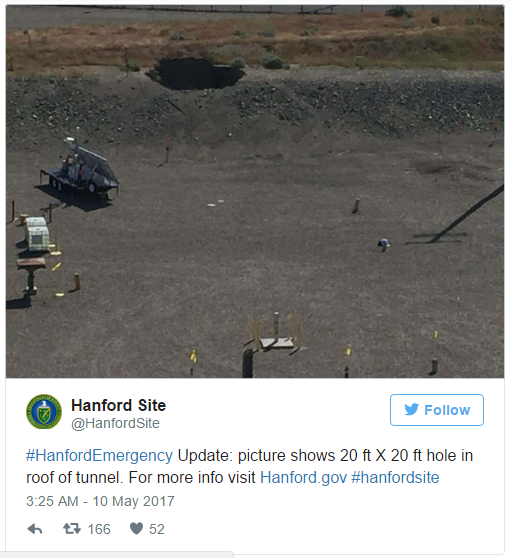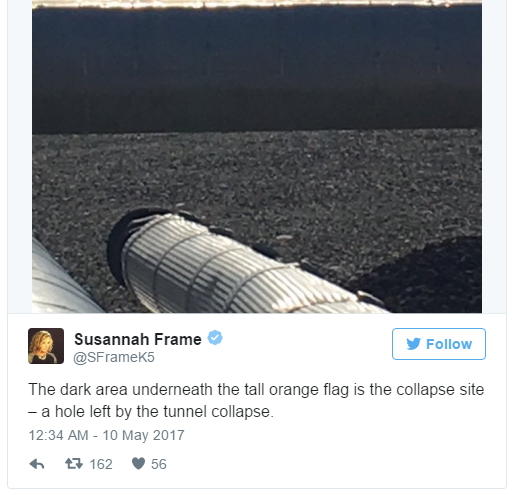|
Update 5: The Spokane Spokesman-Review reports that Gov. Jay Inslee was notified about the tunnel breach by the Energy Department and the White House on Tuesday morning. Inslee called the event “a serious situation.”
“Federal, state and local officials are coordinating closely on the response,” Inslee said, with the state Ecology Department in close communication with the Energy Department. There were no plans for Inslee, who is making several previously planned stops in Skamania County on Tuesday, to go to Hanford, his staff said.
Energy Secretary Rick Perry had been briefed, federal officials said, adding that
“everyone has been accounted for and there is no initial indication of any worker exposure or an airborne radiological release.”
U.S. Sen. Maria Cantwell, D-Wash., released a statement as well:
“Worker safety must be our number one priority, and we need to understand whether there has been any environmental contamination resulting from the subsidence at these tunnels. My thoughts are with the first responders who are working to assess the situation on the ground, monitor any environmental impacts and design next steps for securing the area.”
Update 4: Washington Emergency Management has released a map showing the distances from the incident to various neighborhoods… non-essential employees in 200 East Area have been released. Swing shift north of the WYE Barricade is cancelled.

Update 3: Images of the hole in the roof of the tunnel have been released…

Update 2: An aerial survey midmorning Tuesday showed an opening about 20 feet by 20 feet into the tunnel, which had been covered with about eight feet of soil. As Tri-CityHerald.com reports , the breach could expose the highly radioactive material disposed of in the tunnel to the atmosphere.
No airborne radiation had been detected as of about 10:30 a.m. Radiological surveys were continuing.
Instructions for people to shelter in place were expanded from central Hanford to all of Hanford, including LIGO and the reactor areas along the Columbia River, after the aerial survey. No one is being allowed to enter the site beyond the security barricades.
Earlier in the morning workers near Purex had noticed a 4-foot-by-4-foot depression that was 2 to 4 feet deep over the tunnel.
Workers in Purex were evacuated when the depression was noticed.
About 3,000 workers in central Hanford initially were told to take shelter indoors, including about 1,000 workers at the vitrification plant construction site. Ventilation systems at the vit plant have been turned off as part of the emergency procedure and equipment that could generate heat have powered down.
The DOE announced that secretary Perry is aware of the incident and that there is no initial indication of any worker exposure or an airborne radiological release.

Meanwhile, Private pilots in the area have been told to avoid flying over Hanford. The Hanford Patrol is working with the Federal Aviation Administration to put a formal air restriction in place until the FAA can confirm there is no danger.
Update 1: A robot is being used to sample the contaminated air and soil in the area around the collapse…

And here is a chart of current windflows…

As we detailed earlier, the U.S. Department of Energy activated the Emergency Operations Center Tuesday due to a tunnel collapse at the Hanford nuclear site.



According to KING-TV, a
“tunnel in a plutonium finishing plant collapsed in Hanford early Tuesday morning. The tunnel was full of highly contaminated materials such as hot radioactive trains that transport fuel rods.”


As Breaking911 reports, some workers were being evacuated while others were advised to shelter-in-place. The Hanford Fire Department is on scene and updates will be posted as they are available. Workers in the vicinity are still being sheltered as a precaution.

From the U.S. Department of Energy
“The U.S. Department of Energy (DOE) Richland Operations Office activated the Hanford Emergency Operations Center at 8:26 a.m., after an alert was declared at the 200 East Area. There are concerns about subsidence in the soil covering railroad tunnels near a former chemical processing facility. The tunnels contain contaminated materials.”
Actions taken to protect site employees include:
- Facility personnel have been evacuated
- As a precaution, workers in potentially affected areas of the Hanford Site have gone indoors
- Access to the 200 East Area of the Hanford Site, which is located in the center of the Hanford Site, has been restricted to protect employees

As we detailed previously, radioactive leak problems at the Hanford Site, a nuclear storage tank in Washington State, are nothing new.
We first wrote about the ongoing radioative leakage at the Hanford Nuclear Reservation, created as part of the Manhattan Project to build the atomic bomb, in 2013.

As a reminder, during the Cold War, the project was expanded to include nine nuclear reactors and five large plutonium processing complexes, which produced plutonium for most of the 60,000 weapons in the U.S. nuclear arsenal. Alas, the site has been leaking ever since, as many of the early safety procedures and waste disposal practices were inadequate and Hanford’s operations released significant amounts of radioactive materials into the air and the neighboring Columbia River.

Hanford’s weapons production reactors were decommissioned at the end of the Cold War, but the decades of manufacturing left behind 53 million US gallons of high-level radioactive waste, an additional 25 million cubic feet of solid radioactive waste, 200 square miles of contaminated groundwater beneath the site and occasional discoveries of undocumented contaminations.

The Hanford site represents two-thirds of the nation’s high-level radioactive waste by volume. Today, Hanford is the most contaminated nuclear site in the United States and is the focus of the nation’s largest environmental cleanup. The government spends $2 billion each year on Hanford cleanup — one-third of its entire budget for nuclear cleanup nationally. The cleanup is expected to last decades.
However, as Krugman would say, the government was not spending nearly enough, and after a major documented leak in 2013, over the weekend, thousands of gallons of radioactive waste are estimated to have leaked from the Site once again, triggering an alarm and causing one former worker to label it as “catastrophic.”
As AP reported, the expanded leak was first detected after an alarm went off at the Hanford Nuclear Reservation on Sunday, and on Monday workers were preparing to pump the waste out of the troubled area. They were also trying to determine why the leak became worse.
It’s unclear exactly how much waste spilled out, but estimates place the amount at somewhere between 3,000 and 3,500 gallons, according to the Tri-City Herald.
The problem occurred at the double-wall storage tank AY-102, which has the capacity to hold one million gallons of the deadly waste, and which has been leaking since 2011. At the time, the leak was “extremely small”, and the waste would dry up almost right after spilling out between the inner and outer walls, leaving a salt-like substance behind.
However, over time the small leak got bigger.
In March, the US Department of Energy began pumping what was left in the storage tank, which originally held some 800,000 gallons of waste. However, after leak detector alarms sounded early Sunday morning, crews at Hanford lowered a camera into the two-foot-wide space between the tank’s inner and outer walls. They discovered 8.4 inches of radioactive and chemically toxic waste has seeped into the annulus.

Pumping work on the tank has been halted as officials reevaluate the situation and figure out how to get to the leaked radioactive waste. It’s possible that the leak was made worse when the pumping began, but that has not been confirmed.

Taking a page right out of the TEPCO playbook, the U.S. Department of Energy released a statement Monday calling the leak an “anticipated” outcome of an ongoing effort to empty the tank in question. The Washington state Department of Ecology said, “There is no indication of waste leaking into the environment or risk to the public at this time.”
But one former tank farm worker said the leak should be considered a major problem.
“This is catastrophic. This is probably the biggest event to ever happen in tank farm history. The double shell tanks were supposed to be the saviors of all saviors (to hold waste safely from people and the environment),” said former Hanford worker Mike Geffre.
He should know: Geffre is the worker who first discovered that the tank, known as AY-102, was failing in 2011. In a 2013 series, “Hanford’s Dirty Secrets,” the KING 5 Investigators exposed that the government contractor in charge of the tanks, Washington River Protection Solutions (WRPS), ignored Geffre’s findings for nearly a year. The company finally admitted the problem in 2012.
Another problem: tank AY-102 is just one of 28 double-shell tanks at Hanford (there are 177 underground tanks total) holding nuclear byproducts from nearly four decades of plutonium production on the Hanford Nuclear Site, located near Richland. Initially the plutonium was used to fuel the bombed dropped on Nagasaki, Japan, in World War II.
The new leak poses problems on several fronts. The outer shell of AY-102 does not have the exhaust or filtration system needed to keep the dangerous gases created by the waste in check. Workers have been ordered to wear full respiratory safety gear in the area, but the risk remains. And unlike Fukushima where cleanup crews are aware of the danger, in Hanford virtually nobody is aware of the dangers of the radioactive seepage.

“The hazards to workers just went up by a factor of 10,” said Geffre.
The breakdown calls into question the viability of three other double-shell tanks at Hanford that have the exact design of AY-102. It is not clear how many of them may have comparable “extremely small” leaks which have gotten bigger, and even if there was it is likely that the DOD would not reveal them.
“The primary tanks weren’t designed to stage waste like this for so many years,” said a current worker. “There’s always the question, ‘Are the outer shells compromised’”?
Oh, and let’s not forget that the accumulation of waste in the outer shell also means “the deadliest substance on earth is that much closer to the ground surrounding the tank. And currently there is no viable plan in place to take care of it.”
Or, as Ben Bernanke would say, the Plutonium is contained.
“It makes me sad that they didn’t believe me that there was a problem in 2011,” said Geffre. “I wish they would have listened to me and reacted faster. Maybe none of this would be happening now. It’s an example of a culture at Hanford of ‘We don’t have problems here. We’re doing just fine.’ Which is a total lie,” said Geffre.
Dear Mike, if you think that is bad, you should see what they say about the “markets”…
|